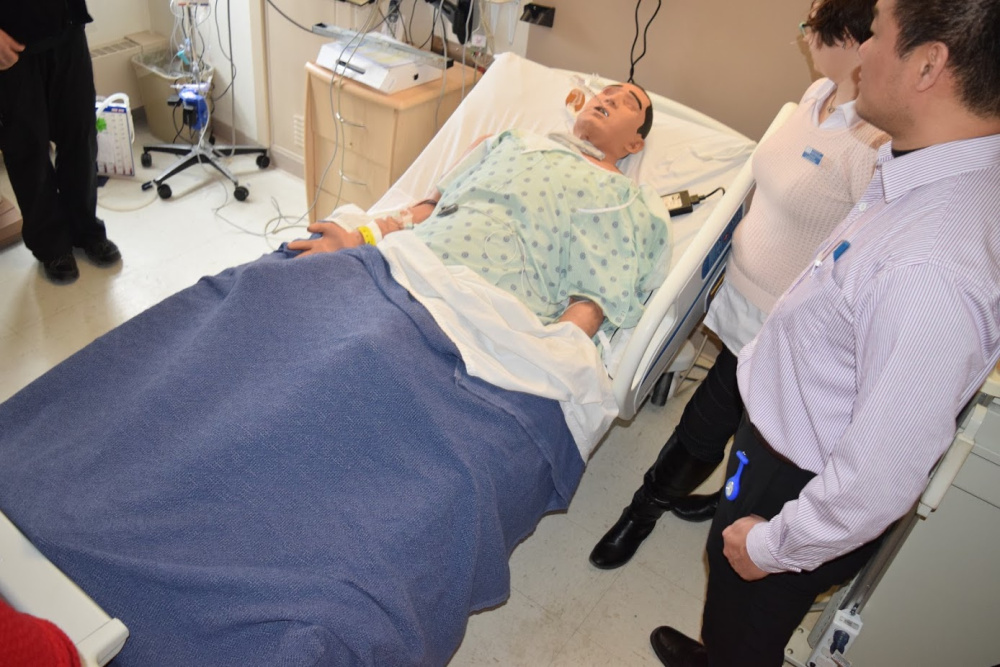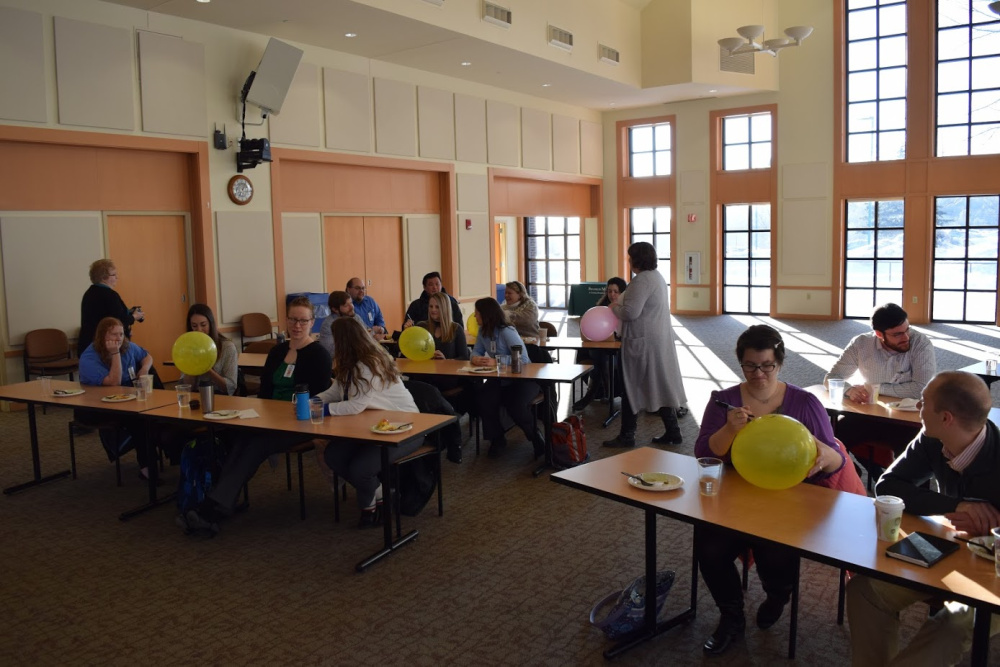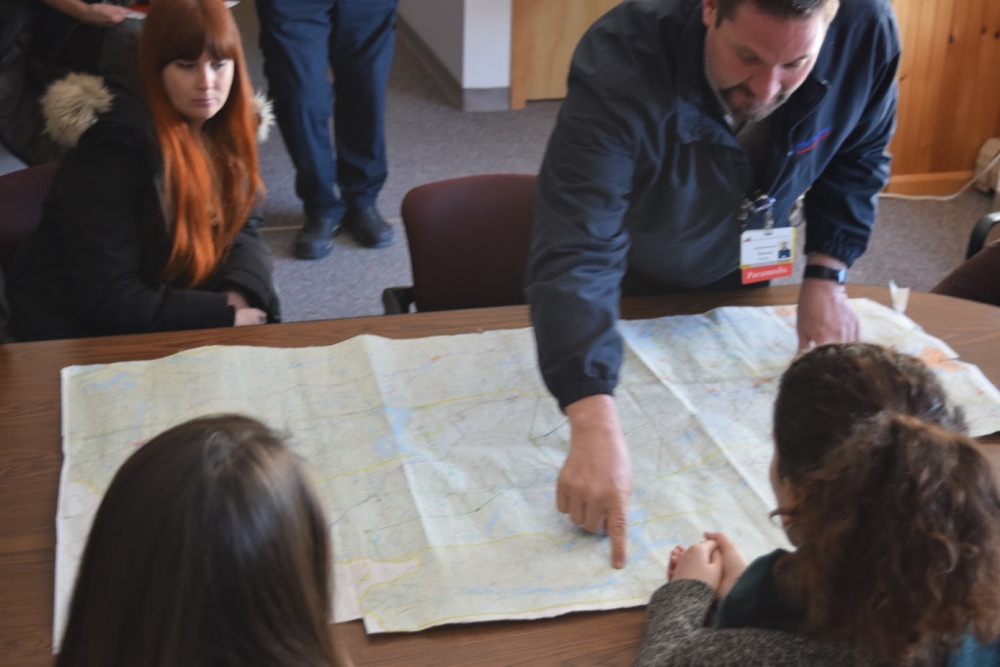FARMINGTON — As warm sunlight filtered through the windows of Franklin Memorial Hospital’s G.H. Bass Room, a group of five University of New England medical and nursing students desperately tried to keep a gaggle of yellow balloons airborne.
The balloons were scrawled with examples of things the students deemed “most important” to them, like family, love or shelter. Tania Dawson, clinical educator for the Western Maine Area Health Education Center, then threw a new balloon into the mix and instructed the students to keep that balloon, before all others, in the air.
As the students jumped and dove, the other balloons quickly fell to the floor. In short order, only the one balloon remained.
“This is what happens with substance misuse,” Dawson said. “All the other things you care about fall away.”
The exercise helped kick off the second year of a University of New England program designed to educate health care students on the unique challenges and rewards facing medical practitioners in rural communities, part of an effort to address the growing shortage of medical personnel in rural areas of Maine and across the nation. The program is also a response to worsening health outcomes in Maine’s rural communities, said Dr. Dora Anne Mills, the program’s head and UNE’s vice president for clinical affairs.
“When you look at the health data in Maine, many of our health indicators are actually getting worse,” Mills said. “And when you look at those in depth, what you see is rural Maine is getting much worse and urban Maine is actually holding steady or getting better.”
AGING POPULATION
This winter’s program takes place in Franklin County, Maine’s second least populous county, with fewer than 31,000 residents in 2010, according to the U.S. Census Bureau. Another trip is scheduled to head to Down East Maine in May.
In 2013, Franklin County had a rate of just 101.7 primary care physicians per 100,000 people compared with 165.3 in Cumberland County, 136.7 in Hancock County and 112.2 in Kennebec County, according to the National Center for Health Statistics.
Nationally, there were 91.1 active primary care physicians per 100,000 people in 2014, according to the American Association of Medical Colleges.
Those numbers don’t tell the whole story, said Gordon Smith, executive vice president of the Maine Medical Association.
“We’re actually quite good on paper, but you’ll never convince somebody in Madawaska of that because (doctors) are mostly in metropolitan areas and they may not even be practicing,” Smith said.
Pointing to a shortage of obstetricians, Smith said, “If you’re in there between Bangor and Houlton, you could be driving two hours to deliver your baby.”
What is clear, Smith said, is that Maine’s population is the oldest in the country and the need for primary care physicians, surgeons and other specialists will continue to grow as the population ages. In rural areas already facing shortages, the need will be even more acute, making necessary efforts like the University of New England program, as well as a similar program through Tufts University.
The UNE program is based on research showing that “early and often” exposure to rural practice for budding health professionals leads to greater recruitment and retention of medical personnel in rural areas, Mills said. In that mold, the program includes a weeklong immersion in rural Maine communities where students are given a chance to learn from physicians, nurses, EMTs and community members about the pros and cons of medical practice.
FINDING THEIR NICHE
The 16 students in this latest group started the week with a moonlit walk on Wilton’s Wilson Lake, an introduction to one of the key advantages of rural living: a close and lasting relationship with the natural world.
The students are all part of UNE’s Care for the Underserved Pathway, a program that aims to expose students to urban, rural and international communities struggling with inadequate medical care. In the course of their studies, these medical and nursing students have the opportunity to serve in a variety of underserved environments.
“I’m definitely interested in experiencing a lot of different communities to see maybe where my niche is,” said first-year osteopathic medical student Stephanie Czajkowski, 30, of Syracuse, New York. “So rural medicine certainly isn’t ruled out for me. I’m here to learn more.”
Dawson, the clinical educator, admits that asking medical professionals to practice in rural areas is not the easiest sell. The salaries are typically lower, at least on paper, and many students fear they will be unable to pay off the hundreds of thousands of dollars in student loans they take out to attend medical school. Dawson also pointed to a pervasive and persistent impression among health care professionals that rural medical facilities provide lesser care for patients and fewer career opportunities, a perception she is determined to change using examples of Franklin Community Health Network’s specialized care for drug-addicted newborns, oncology services and sleep studies.
Still, Dawson warns that practicing in a small town requires a more significant commitment to that community than many practitioners initially realize. Because they’re among the few medical professionals in the area, physicians, nurses and other health care workers can expect to become integral parts of their community. That can translate into long hours, few days off and little to no anonymity. As students heard from Dr. Michele McCormick, a pediatrician at Franklin Memorial Hospital, even going to the grocery store requires calculation, including whether she can schedule in the time she will inevitably spend speaking with patients and community members she runs into.
“They don’t realize how difficult it is to be the only provider in an area, and they don’t stay because it is difficult,” Dawson said.
There are also cultural barriers that many practitioners must learn to overcome as they earn the trust of rural Maine’s fiercely independent residents. As medical staff members in Franklin County reckon with the explosive opioid crisis that has struck much of the state, Dawson said, they must grapple with a culture of silence among affected individuals and communities paired with deep-seated resistance to accepting charity.
‘THEY DON’T KNOW YOU’
“They see it every day how people get judged and don’t have the ability to get a job, keep a job, keep their kids,” Dawson said. “The culture is just not accepting. And we need to change that. It’s always been seen as a choice.”
“They’re a generous, generous community and they’re very reluctant to accept help,” she said. “You have to have a relationship with them before you can offer them help because they won’t take it because they don’t know you.”
But for practitioners who are willing to make the investment, Dawson said, rural practice is not only worth it, it’s preferable. The rewards come in the form of deep appreciation from close-knit communities, lower cost of living and easy access to the outdoors that more than make up for fewer conveniences.
“You know what I’m not going to tell you that you can get a burger at 2 a.m. here. You can’t,” Dawson said. “But you can get a pretty darn good one at like 8.”
Kate McCormick can be contacted at or at: 861-9218
kmccormick@centralmaine.com
Twitter: KateRMcCormick
Send questions/comments to the editors.






Comments are no longer available on this story